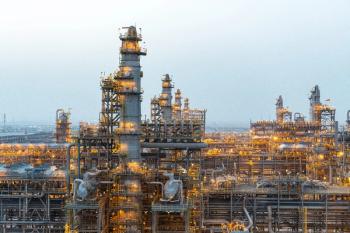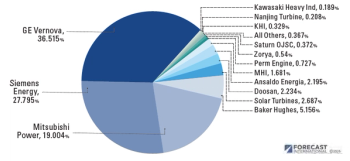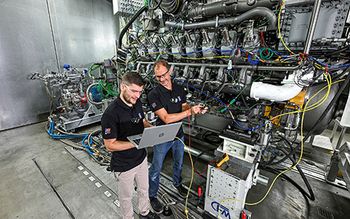
- November/December 2024
- Volume 65
- Issue 7
Myth: Hydrogen Handling is Effortless
Hydrogen transport and storage are technically challenging and present significant operational and safety issues that must be addressed.
Using hydrogen as a fuel for power generation is a viable answer to the problem of intermittent availability of renewables like solar or wind. The famous duck curve describes the plight of power generators when renewables provide a significant percentage of electricity to the grid: Conventional power generation has to be quickly ramped up when the available amount of renewable electricity starts to decline during high-demand periods, for example in the evening. At some point, baseload plants—i.e., power plants that can very efficiently operate at or near full load but have limited turndown and ramp-up capabilities—will not be able to contribute effectively to such a grid. The only alternative (besides batteries and other mechanical or thermal energy storage) is gas turbine plants, and these plants are only carbon-neutral if either the fuel is carbon-free or the CO2 from fossil fuels is captured and sequestered.
HYDROGEN AS A FUEL
Hydrogen as a fuel for gas turbines is a possible way out of the conundrum because hydrogen can be stored to balance supply and demand. In other words, hydrogen can be produced from solar and wind power at the rate these energy sources are available, and the surplus can be stored in large quantities for when demand surges. Generally, the location of hydrogen production, storage, and consumption is not identical, thus hydrogen needs to be transported unless all three functions are met at the same site, and only electricity is transported. We have also learned that the compression of hydrogen—for example from electrolyzer pressure to storage or pipeline pressure or along the pipeline to compensate for ubiquitous friction losses in the pipeline—is significantly more energy-intensive on a per-mass or per-energy content basis than handling natural gas, for example.
Gas turbines have been used to burn pure hydrogen in the past. In fact, some of the early aircraft gas turbines in the 1930s were actually tested using hydrogen as a fuel. The only problem is that the high temperature of a hydrogen flame creates far higher NOx emissions than other fuels. Manufacturers are developing combustion systems to lower flame temperatures or provide exhaust treatment systems to remove some of the NOx if conventional diffusion-flame systems are used.
So, are there other options to transport and store gaseous hydrogen? Lowering the temperature of the hydrogen to form a liquid, like what is currently done with LNG for transport by tanker or ship, seems attractive. And indeed, there are commercial applications currently for liquid hydrogen as a rocket fuel and even for fueling highway trucks. The downside of liquefaction is the amount of energy needed to reach the necessary low temperature (the boiling point of hydrogen at atmospheric pressure is about - 423° F), which also needs to be maintained during any transport process. This means the energy required for the refrigeration process to liquify hydrogen is equivalent to 30 - 40% of the energy content of the hydrogen itself.
Other options are creating hydrogen-containing compounds such as gaseous methane (CH4) or liquid organic hydrogen carriers (LOHC). LOHC are chemical compounds such as toluene, naphthalene, cyclohexane, and methylcyclohexane with a hydrogen storage capacity of 5 - 8% by weight. They can chemically absorb hydrogen by hydration in an exothermic reaction under pressure and can later be dehydrated in an endothermic reaction. Therefore, they can store significant amounts of hydrogen at ambient temperatures and pressures. However, liberating stored hydrogen requires a significant amount of heat and temperature, possibly as much as 20 - 30% of the transported energy. Ammonia and LOHCs are generally transported as liquids while methane is transported as a gas—and usually does not require any modifications for existing natural gas pipelines and storage systems.
OTHER FUELS
Other options include ammonia (NH3), methanol (CH3OH), ethanol (C2H5OH), and dimethyl ether (C2H6O, aka DME).
Hydrogen created by electrolysis can be further converted to methane by a methanation process. In the methanation process, CO2 and hydrogen form methane. A German car manufacturer demonstrated this process, but the round-trip efficiency is generally worse than hydrogen electrolysis, even when considering the less energy-intensive transport. When used as fuel for cars, hydrogen can use proven compressed natural gas (CNG) technology.
Long-chain hydrocarbon molecules, such as methanol or other e-fuels, can be produced from synthesis gas using a process known as Fischer-Tropsch synthesis or by methanol synthesis that enables the direct conversion of CO2 and H2 into methanol, making a previous CO2 reduction obsolete. The CO2-based methanol synthesis yields a mixture of methanol and water subsequently separated through distillation. These molecules are the essential components of e-fuels and chemically correspond to the molecules also contained in the fossil fuels we know today. Both methane and methanol production require CO2 as a precursor ingredient. The energy requirements to capture atmospheric CO2 (at 400 ppm atmospheric concentration) are of course much higher than capturing CO2 from exhaust gas or industrial processes where the concentrations are much higher, in the single- or double-digit percent range.
AMMONIA
Currently, ammonia is getting significant attention as the transport vehicle of choice. It can be transported as a liquid, which makes the transport process efficient. Certainly, making ammonia is well understood, as it is a key ingredient in fertilizer manufacturing. Having hydrogen available in fertilizer production avoids several production steps that ultimately lead to making ammonia, such as in the well-known Haber Bosch process. This means that the use of ammonia as fuel has to compete with the use of ammonia for fertilizer production. Currently, most of the world’s ammonia goes into fertilizer production. If ammonia demand drastically increases, then prices for ammonia will also increase and affect the cost of producing most of the world’s food products. You may remember what happened to tortilla prices in Mexico when lots of corn from the United States started to be used for biofuels instead of sold for food and feed. There were riots in the streets in Mexico. Similar, but far worse, could happen if we artificially increase the demand for ammonia through government green tariffs, subsidies, or taxes. Fertilizer costs make up about 20 - 40% of the cost of producing grains. Bread (and far worse, beer) prices will go up drastically.
In the euphoria over (green) ammonia as a fuel, some key facts have been talked down: Ammonia is highly corrosive, so all wetted surfaces may require austenitic steels. Transporting ammonia is difficult because ammonia is toxic and when combined with water becomes caustic: At ambient conditions, ammonia forms a toxic gas. In liquid form, risks of exposure increase if under pressure, as large quantities have the potential to rapidly release into the air. For example, liquefied ammonia has an expansion ratio of approximately 850 to 1. A large vapor cloud will form traveling close to the ground. During a catastrophic spill, ammonia may be released as both a vapor and through a unique phenomenon as a freezing boiling liquid. The dense-gas behavior is not fully researched to better predict how buoyant ammonia behaves in real-world environments.
Using ammonia as a fuel requires either to separate the nitrogen and hydrogen and use the hydrogen as a fuel or to develop combustion systems for ammonia. To decompose ammonia into hydrogen and nitrogen, an ammonia cracker is used. First, the ammonia is heated until it evaporates into a gaseous state. It is then fed into the reactor where ammonia splitting takes place catalytically. Usually, the process runs at temperatures of 600 - 900° C and a pressure of 50 - 100 bar. Ammonia as a fuel produces high NOx emissions because of fuel-bound nitrogen and thus will likely require post-combustion treatment.
Ammonia production is a well-proven process that produces large quantities. Methanol production is also a well-understood process, deployed since the 1970s. Making methane from green electricity has only been applied in a 6-MW plant, but this might be scalable. Producing and using other LOHCs in larger quantities is mostly unproven.
The short description of various options to transport hydrogen really proves one point: Hydrogen transport and storage are not trivial! They are technically challenging and present significant operational and safety issues that need to be addressed before large-scale hydrogen transport, storage, and distribution can become commercially viable.
About the Authors
Klaus Brun is the Director of R&D at Ebara Elliott Energy. He is also the past Chair of the Board of Directors of the ASME International Gas Turbine Institute and the IGTI Oil & Gas applications committee.
Rainer Kurz is a recent retiree from Manager of Gas Compressor Engineering at Solar Turbines Inc. in San Diego, CA. He is an ASME Fellow and has published over 200 articles and papers in the turbomachinery field.
Articles in this issue
12 months ago
Turbomachinery International: November/December 2024Newsletter
Power your knowledge with the latest in turbine technology, engineering advances, and energy solutions—subscribe to Turbomachinery International today.





